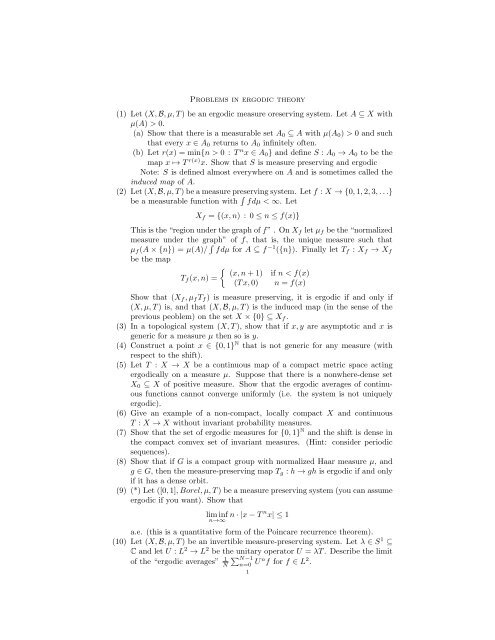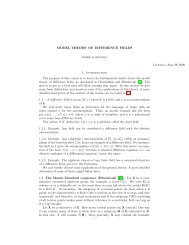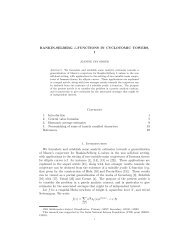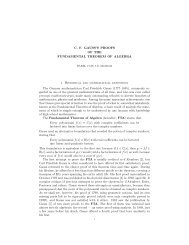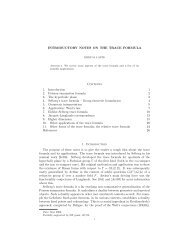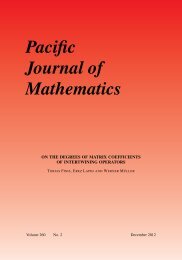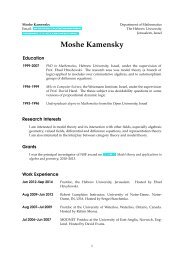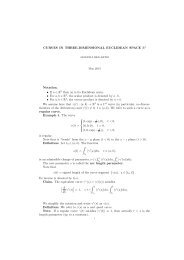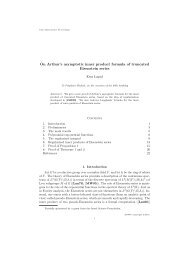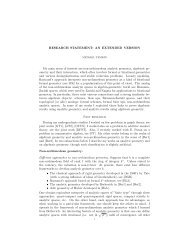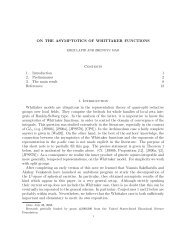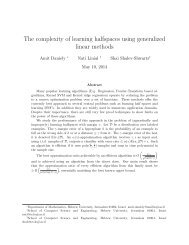Problems in ergodic theory (1) Let (X, B, µ, T) be an ergodic ...
Problems in ergodic theory (1) Let (X, B, µ, T) be an ergodic ...
Problems in ergodic theory (1) Let (X, B, µ, T) be an ergodic ...
You also want an ePaper? Increase the reach of your titles
YUMPU automatically turns print PDFs into web optimized ePapers that Google loves.
<strong>Problems</strong> <strong>in</strong> <strong>ergodic</strong> <strong>theory</strong>(1) <strong>Let</strong> (X, B, µ, T ) <strong>be</strong> <strong>an</strong> <strong>ergodic</strong> measure oreserv<strong>in</strong>g system. <strong>Let</strong> A ⊆ X withµ(A) > 0.(a) Show that there is a measurable set A 0 ⊆ A with µ(A 0 ) > 0 <strong>an</strong>d suchthat every x ∈ A 0 returns to A 0 <strong>in</strong>f<strong>in</strong>itely often.(b) <strong>Let</strong> r(x) = m<strong>in</strong>{n > 0 : T n x ∈ A 0 } <strong>an</strong>d def<strong>in</strong>e S : A 0 → A 0 to <strong>be</strong> themap x ↦→ T r(x) x. Show that S is measure preserv<strong>in</strong>g <strong>an</strong>d <strong>ergodic</strong>Note: S is def<strong>in</strong>ed almost everywhere on A <strong>an</strong>d is sometimes called the<strong>in</strong>duced map of A.(2) <strong>Let</strong> (X, B, µ, T ) <strong>be</strong> a measure preserv<strong>in</strong>g system. <strong>Let</strong> f : X → {0, 1, 2, 3, . . .}<strong>be</strong> a measurable function with ´ fdµ < ∞. <strong>Let</strong>X f = {(x, n) : 0 ≤ n ≤ f(x)}This is the “region under the graph of f” . On X f let µ f <strong>be</strong> the “normalizedmeasure under the graph” of f, that is, the unique measure such thatµ f (A × {n}) = µ(A)/ ´ fdµ for A ⊆ f −1 ({n}). F<strong>in</strong>ally let T f : X f → X f<strong>be</strong> the map{(x, n + 1) if n < f(x)T f (x, n) =(T x, 0) n = f(x)Show that (X f , µ f T f ) is measure preserv<strong>in</strong>g, it is <strong>ergodic</strong> if <strong>an</strong>d only if(X, µ, T ) is, <strong>an</strong>d that (X, B, µ, T ) is the <strong>in</strong>duced map (<strong>in</strong> the sense of theprevious peoblem) on the set X × {0} ⊆ X f .(3) In a topological system (X, T ), show that if x, y are asymptotic <strong>an</strong>d x isgeneric for a measure µ then so is y.(4) Construct a po<strong>in</strong>t x ∈ {0, 1} N that is not generic for <strong>an</strong>y measure (withrespect to the shift).(5) <strong>Let</strong> T : X → X <strong>be</strong> a cont<strong>in</strong>uous map of a compact metric space act<strong>in</strong>g<strong>ergodic</strong>ally on a measure µ. Suppose that there is a nonwhere-dense setX 0 ⊆ X of positive measure. Show that the <strong>ergodic</strong> averages of cont<strong>in</strong>uousfunctions c<strong>an</strong>not converge uniformly (i.e. the system is not uniquely<strong>ergodic</strong>).(6) Give <strong>an</strong> example of a non-compact, locally compact X <strong>an</strong>d cont<strong>in</strong>uousT : X → X without <strong>in</strong>vari<strong>an</strong>t probability measures.(7) Show that the set of <strong>ergodic</strong> measures for {0, 1} N <strong>an</strong>d the shift is dense <strong>in</strong>the compact comvex set of <strong>in</strong>vari<strong>an</strong>t measures. (H<strong>in</strong>t: consider periodicsequences).(8) Show that if G is a compact group with normalized Haar measure µ, <strong>an</strong>dg ∈ G, then the measure-preserv<strong>in</strong>g map T g : h → gh is <strong>ergodic</strong> if <strong>an</strong>d onlyif it has a dense orbit.(9) (*) <strong>Let</strong> ([0, 1], Borel, µ, T ) <strong>be</strong> a measure preserv<strong>in</strong>g system (you c<strong>an</strong> assume<strong>ergodic</strong> if you w<strong>an</strong>t). Show thatlim <strong>in</strong>fn→∞ n · |x − T n x| ≤ 1a.e. (this is a qu<strong>an</strong>titative form of the Po<strong>in</strong>care recurrence theorem).(10) <strong>Let</strong> (X, B, µ, T ) <strong>be</strong> <strong>an</strong> <strong>in</strong>vertible measure-preserv<strong>in</strong>g system. <strong>Let</strong> λ ∈ S 1 ⊆C <strong>an</strong>d let U : L 2 → L 2 <strong>be</strong> the unitary operator U = λT . Descri<strong>be</strong> the limitof the “<strong>ergodic</strong> averages” 1 ∑ N−1N n=0 U n f for f ∈ L 2 .1
2(11) <strong>Let</strong> X = {z ∈ C : |z| ≤ 1} with normalized area measure µ, <strong>an</strong>d letT (re iθ ) = re i(θ+r) .(a) Show that T preserves µ.(b) Is µ <strong>ergodic</strong>? Descri<strong>be</strong> its <strong>ergodic</strong> components.(c) What is the pure-po<strong>in</strong>t spectrum of T ?(12) <strong>Let</strong> (X, B, µ, T ) <strong>be</strong> <strong>an</strong> <strong>in</strong>vertible <strong>ergodic</strong> measure preserv<strong>in</strong>g system <strong>an</strong>d1 < n ∈ N. Show that the follow<strong>in</strong>g are equivalent:(a) T n is <strong>ergodic</strong>.(b) If k divides n then e 2πik/n /∈ N.(c) There is a measurable partition X = X 1 ∪ . . . ∪ X n with T X i =X i+1 mod n up to measure 0.(13) <strong>Let</strong> (X, B, µ, T ) <strong>be</strong> <strong>an</strong> <strong>in</strong>vertible measure preserv<strong>in</strong>g system. <strong>Let</strong> t 0 > 0 <strong>an</strong>ddef<strong>in</strong>e a new map S : X × [0, 1) → X × [0, 1) byS t0 (x, t) = (T [t+t0] x, {t + t 0 })(a) Show that this map preserves ν = µ×Leb| [0,1) . Show that S t S s = S t+s ,so <strong>in</strong> fact we have <strong>an</strong> action of R on X × [0, 1).(b) Determ<strong>in</strong>e when S t0 is <strong>ergodic</strong>. Descri<strong>be</strong> its <strong>ergodic</strong> components <strong>an</strong>dits spectrum.(14) A jo<strong>in</strong><strong>in</strong>g of topological dynamical systems (X, T ) <strong>an</strong>d (Y, S) is a closed<strong>an</strong>d T × S-<strong>in</strong>vari<strong>an</strong>t subset of X × Y that projects under the coord<strong>in</strong>atemaps to X, Y , respectively. The systems are disjo<strong>in</strong>t if the only jo<strong>in</strong><strong>in</strong>g is theproduct jo<strong>in</strong><strong>in</strong>g. Show that if X, Y support <strong>ergodic</strong> <strong>in</strong>vari<strong>an</strong>t measures µ, ν,respectively, with supp µ = X <strong>an</strong>d supp ν = Y , <strong>an</strong>d if (X, µ, T ) ⊥ (Y, ν, S),then the topological systems are disjo<strong>in</strong>t.(15) Show that disjo<strong>in</strong>tness of topological dynamical systems (X, T ), (Y, S) doesnot imply disjo<strong>in</strong>tness of every pair of <strong>in</strong>vari<strong>an</strong>t measures µ ∈ P(X) <strong>an</strong>dν ∈ P(Y ). H<strong>in</strong>t: Consider X = {0, 1} Z <strong>an</strong>d Y a periodic orbit.(16) If (X, B, µ, T ) ⊥ (Y, C, ν, S), is (X, B, µ, T ) ⊥ (Y, C, ν, S −1 )?(17) <strong>Let</strong> (X, B, µ, T ), (Y, C, ν, S) <strong>be</strong> <strong>ergodic</strong> group rotations. Show that (X, B, µ, T m ) ⊥(Y, C, ν, S n ) for all m, n ≠ 0.(18) <strong>Let</strong> (X, B, µ, T ) <strong>an</strong>d f ∈ L 1 (µ). Show that for µ-a.e. x the sequencea n = f(T n x) has the follow<strong>in</strong>g property. If (X, B, µ, T ) ⊥ (Y, C, ν, S) thenfor every g ∈ L 1 (ν),1∞∑ˆ ˆlim a n g(S n y) → f · g ν-a.e. yn→∞ Nn=1H<strong>in</strong>t: you may assume X, Y are compact <strong>an</strong>d T, S cont<strong>in</strong>uous. First proveit for f, g cont<strong>in</strong>uous.(19) Show that a stationary process (X n ) ∞ n=−∞ with trivial tail is strongly mix<strong>in</strong>g.(20) Construct a probability vector p = (p 1 , p 2 , . . .) such that H(p) = ∞.(21) Prove that for <strong>an</strong>y f<strong>in</strong>ite-valued r<strong>an</strong>dom variables X, Y, Z we have H(X|Y, Z) ≥H(X|Y ) (we used this repeatedly <strong>in</strong> class, but did not prove it. H<strong>in</strong>t: consultthe proof that H(X|Y ) ≥ H(X)). Show the same when the condition<strong>in</strong>gis on σ-algebras.(22) Prove that the product measure µ = (1/2, 1/2) Z is the only measure on{0, 1} Z with h µ (S) = 1 (all others are ≤ 1). Conclude that if π : {0, 1} Z →
3{0, 1] Z is a cont<strong>in</strong>uous map satisf<strong>in</strong>g πS = Sπ (S the shift), then if π is 1-1,it must <strong>be</strong> onto.(23) Prove that if µ n ∈ P({0, 1} Z ) are shift <strong>in</strong>vari<strong>an</strong>t <strong>an</strong>d µ = lim µ n weak-*,then h µ (S) ≥ lim sup h µn (S). Show that strict <strong>in</strong>equality c<strong>an</strong> occur (<strong>in</strong>fact we c<strong>an</strong> have h µn (S) = 0 <strong>an</strong>d h µ (S) = 1). Show that this lower semicont<strong>in</strong>uitydoesn’t hold <strong>in</strong> general for <strong>in</strong>vari<strong>an</strong>t measures on topologicaldynamical systems (H<strong>in</strong>t: construct a topological space <strong>in</strong> which there is asequence X n ⊆ X of <strong>in</strong>vari<strong>an</strong>t subshifts, each of which supports measuresof entropy 1, but such that X n “converge” to a fixed po<strong>in</strong>t of the map).(24) Show that h µ×ν (T × S) = h µ (T ) + h ν (S).(25) Prove that if (X, B, µ, T ) is weak mix<strong>in</strong>g then for <strong>an</strong>y non-trivial partitionα of X, there is a sequence n k → ∞ such that 1 N H(∨ Nk=1 T −n kα) → 1.(26) Give <strong>an</strong> example of <strong>an</strong> <strong>ergodic</strong> measure preserv<strong>in</strong>g system with <strong>in</strong>f<strong>in</strong>iteentropy, <strong>an</strong>d conclude that it does not have a generat<strong>in</strong>g partition.(27) <strong>Let</strong> X = {±1} Z × {±1} Z , <strong>an</strong>d def<strong>in</strong>e the map X → X by T (x, y) =(Sx, S x(0) y) where S : {±1} Z → {±1} Z is the shift. <strong>Let</strong> µ = µ 0 × µ 2where µ 0 = µ 1 = (1/2, 1/2) Z . This system is called the “T, T −1 ”. It is alsocalled “r<strong>an</strong>dom walk <strong>in</strong> r<strong>an</strong>dom scenery”, <strong>be</strong>cause the first sequence x c<strong>an</strong><strong>be</strong> thought of as the <strong>in</strong>crements of a symmetric r<strong>an</strong>dom walk on the <strong>in</strong>tegers;as time goes by we shift the x sequence, produc<strong>in</strong>g these <strong>in</strong>crements,<strong>an</strong>d shift the y-sequence either forward or backward accord<strong>in</strong>g to this <strong>in</strong>crement.Thus, if we view only they sequence, we see a r<strong>an</strong>dom sequenceof digits <strong>be</strong><strong>in</strong>g shifted left <strong>an</strong>d right r<strong>an</strong>domly.(a) Show that (X, T, µ) is measure-preserv<strong>in</strong>g (this is a special case of theskew product construction we talked about <strong>in</strong> class).(b) Consider the process (X n , Y n )(x, y) = (x n , y n ). Show that given (X 0 −∞, Y 0 −∞)one c<strong>an</strong> determ<strong>in</strong>e the entire sequence Y ∞ −∞. H<strong>in</strong>t: Use recurrence ofr<strong>an</strong>dom walk on Z. Conclude that h((X n , Y n ) ∞ −∞) = log 2.(c) Show that the process above nevertheless has trivial tail.Remark: This process turns out to <strong>be</strong> a process with trivial tail that isnot isomorphic to a product measure, although this is not trivial to prove.An earlier example was constructed by Ornste<strong>in</strong> more explicitly.(28) A factor map π : X → Y <strong>be</strong>tween measure preserv<strong>in</strong>g systems is calledbounded-to-1 if |π(y) −1 | < M for some const<strong>an</strong>t M <strong>an</strong>d a.e. y ∈ Y , <strong>an</strong>df<strong>in</strong>ite-to-1 if π −1 (y) is f<strong>in</strong>ite for a.e. y ∈ Y . Show <strong>in</strong> both cases thath(X) = h(Y ) (<strong>be</strong>g<strong>in</strong> with the bounded-to-1 case, which is easier).


